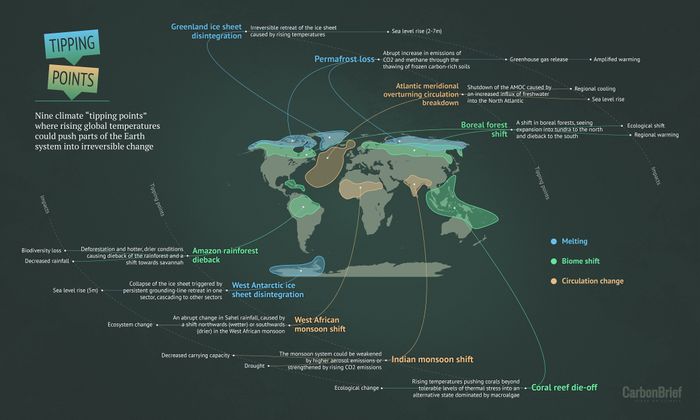Global ecological tipping point: Difference between revisions
From BurnZero
No edit summary |
No edit summary |
||
| Line 1: | Line 1: | ||
Past these tipping points, scientists recon there is no way back<ref>https://illuminem.com/energyvoices/80df1713-3292-4626-911f-48decadc37ae?fbclid=IwAR1mTkC2LAoJy92kIninjXbu0ULxIOLGqymTzD7tbxfnENdlDBuqKjn-0bA</ref>. | Past these tipping points, scientists recon there is no way back<ref>https://illuminem.com/energyvoices/80df1713-3292-4626-911f-48decadc37ae?fbclid=IwAR1mTkC2LAoJy92kIninjXbu0ULxIOLGqymTzD7tbxfnENdlDBuqKjn-0bA</ref>: | ||
[[File:Ecological-tipping-points.jpg|alt=Ecological-tipping-points|center|thumb|700x700px|Ecological-tipping-points]] | |||
*'''The Arctic''': the average temperature of the Arctic has increased 2.3°C since the 1970s. Ice dependent species such as narwhals, polar bears, and walruses are at increasing risk with shrinking sea ice cover. By 2100, polar bears could face starvation and reproductive failure even in far northern Canada. | *'''The Arctic''': the average temperature of the Arctic has increased 2.3°C since the 1970s. Ice dependent species such as narwhals, polar bears, and walruses are at increasing risk with shrinking sea ice cover. By 2100, polar bears could face starvation and reproductive failure even in far northern Canada. | ||
Revision as of 05:47, 28 May 2022
Past these tipping points, scientists recon there is no way back[1]:
- The Arctic: the average temperature of the Arctic has increased 2.3°C since the 1970s. Ice dependent species such as narwhals, polar bears, and walruses are at increasing risk with shrinking sea ice cover. By 2100, polar bears could face starvation and reproductive failure even in far northern Canada.
- West Antarctic sea ice: we could lose this within ten years, and if so, sea levels will eventually rise three metres because of it.
- Amazon Rainforest: the current projection is that we have five to ten years before the rainforest tips into a new state, that of a savannah.
- Greenland ice sheet: we could lose this in 20 to 25 years, and if so, sea levels will eventually rise seven metres because of it.
References
